
The author and publisher have provided this e-book to you for your personal use only. You may not make this e-book publicly available in any way. Copyright infringement is against the law. If you believe the copy of this e-book you are reading infringes on the authors copyright, please notify the publisher at: us.macmillanusa.com/piracy.
Contents
For
Susan, Akira, Nik, and Ruth,
and for
my entire kulaparampar
 c ak
c ak  re param vyman ysmin dev
re param vyman ysmin dev  dhi vve ni
dhi vve ni  ed
ed  |
|
ys tn n vda km  c
c  kari
kari  yati y t td vids t im sm sate ||
yati y t td vids t im sm sate ||
RIGVEDA 1.164.39, THE RIDDLE HYMN ON OM
That syllable of the Rigveda, that highest space where all the gods have taken their places. What will he do with the Rigveda who does not know that syllable? Only those who know that sit together here with me!
A Note on This Translation
Charles Wilkins published the first translation of the Bhagavad Gt into English in 1785, and there has been a steady stream of new translations ever since then. So inevitably a question arises that a translator of a new one must face: Why yet another version? This is my best attempt at an answer.
I have been teaching this text for many years, and I have used many of the available translations. There are quite a few reasonably reliable and accurate translations among them, but students have generally not responded well to the scholarly ones. I have no elaborate theory of translation, but because I am a philologist, I prefer an accurate translation to a loose one that may be more eloquent. Some eloquent translations of the Bhagavad Gt have been made by people with little or no training in Sanskrit. Occasionally a student will ask me for permission to use one of them. I take such opportunities to compare translations, to show my students how different they can be. In this way, I emphasize the importance of choosing a translation that is accurate over one that may be easier to read or that appeals to a preconception that we might have of a given text, or religion, or culture. The popular literature that is readily available, not only in print but also increasingly online, concerning the traditions that I study and teach tends to conceal or ignore the little details that can make one tradition or text or passage distinctive, and therefore interesting.
I think it is necessary to try to present a text like the Bhagavad Gt not only as accurately as possible, but also with a commitment to conveying its importance, both to those within its social and historical contextwhich in the case of the Bhagavad Gt is very great indeed!and to those whom we invite (or, in the case of students, require) to read it.
One of the reasons that I have taken up this translation is that I have long felt the need for one that is both accurate and engagingand perhaps even eloquent. Over the years my students have complained that the verse translations of the Bhagavad Gt were awkward, stiff, and sometimes hardly poetic at all. But my decision to make a vigorous, rhythmic prose translation is also rooted in my aim to make, first of all, an accurate translation. The Bhagavad Gt is composed in a metrical form, mostly in a quatrain of eight-syllable lines known in Sanskrit as the loka , or the anu 
 ubh . Occasionally the Bhagavad Gt shifts into longer quatrains of four lines of eleven syllables, in interesting ways and at interesting times. But I think it has been a mistake to try to imitate or reproduce the quatrain stanzas in English.
ubh . Occasionally the Bhagavad Gt shifts into longer quatrains of four lines of eleven syllables, in interesting ways and at interesting times. But I think it has been a mistake to try to imitate or reproduce the quatrain stanzas in English.
The Bhagavad Gt is a small section of that massive Sanskrit epic the Mahbhrata, the great encyclopedia of classical Indian culture. At its core, this encyclopedia is essentially an epic tradition; that is, it is fundamentally a narrative of war. The meter of Sanskrit epic poetry is not an elegant, finely tuned, finely crafted musical composition. In Sanskrit literature, such musical compositions were known as kvya , a refined and complex genre of courtly poetry, intended for a highly educated elite audience. Sanskrit epic poetry, on the other hand, was governed by a loose and irregular meter, the primary function of which was simply to move the narrative along, quickly and easily. The Sanskrit of the epics, and of the Bhagavad Gt, is much closer in fact to the colloquial everyday Sanskrit of the first century of the Common Era ( C.E .). It is a vibrant and rhythmic kind of Sanskrit, much closer to what the spoken Sanskrit of the Brahmins and the warrior elite ( k  atriya s) must have sounded like at the time than to the earlier fundamentally esoteric poetry of the Rigveda, or to the later poetic language of Klidsa and the other courtly poets of classical India. Like the language of other epic poetries known to us, it is formulaic and improvisational. It is fast-paced and was readily accessible to its intended audience. What such an epic poetry needs in translation is a similarly colloquial, direct, and fast-paced English. That is what I have tried to produce in this translation.
atriya s) must have sounded like at the time than to the earlier fundamentally esoteric poetry of the Rigveda, or to the later poetic language of Klidsa and the other courtly poets of classical India. Like the language of other epic poetries known to us, it is formulaic and improvisational. It is fast-paced and was readily accessible to its intended audience. What such an epic poetry needs in translation is a similarly colloquial, direct, and fast-paced English. That is what I have tried to produce in this translation.
To be sure, the Bhagavad Gt does have highly poetic, even lyrical moments. It uses poetic figures more frequently than the Mahbhrata does as a whole, which is one reason why it is considered a later addition to the Mahbhrata. Nonetheless, the Bhagavad Gts poetic context, or rather its performance context, is much closer to the contemporary vernacularthat is, to ordinary speechthan to a high-register poetic language. And while the text undoubtedly contains many passages of genuine poetic brilliance and intensity, one also has to acknowledge that many passages in the Bhagavad Gt are poetically very ordinary, and that a few are unconvertible, even by a great translator, into genuine poetry. Many of them come in the last six chapters, but even in the earlier chapters one sometimes encounters strange, awkward passages. One well-known example is Chapter 6, stanzas 57, where, in the course of two and a half brief loka s, we encounter the word tman no fewer than fifteen times. In stanza 6.5 alonea mere thirty-two syllables in lengththe word occurs seven times! I have spent a lot of time trying to work out how to translate this passage, and this is the best I could come up with:
5. One should lift one self up by means of the self . Do not degrade the self , for the self is ones only friend, and at the same time the self is ones only foe.
6. The self is ones friend when one has conquered the self by means of the self. But when a man neglects the self, then, like an enemy at war, that very self will turn against him.
7. A peaceful man who has mastered himself has a higher self that is deeply concentrated, whether in cold or in heat, whether in pleasure or in pain, whether in honor or in disgrace.


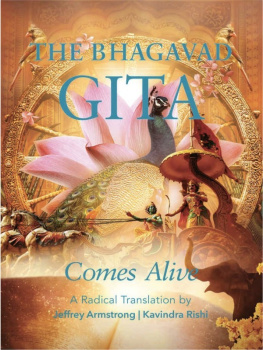
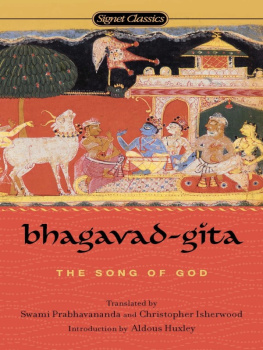
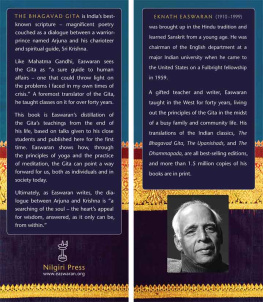
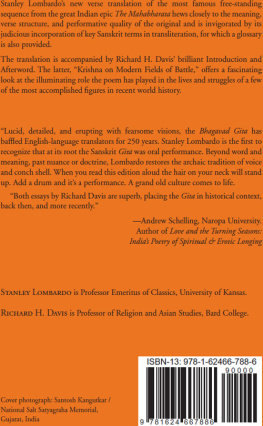
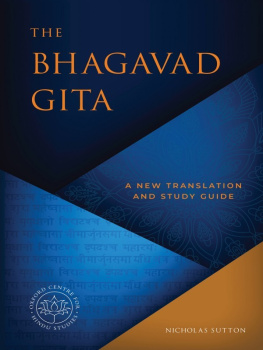
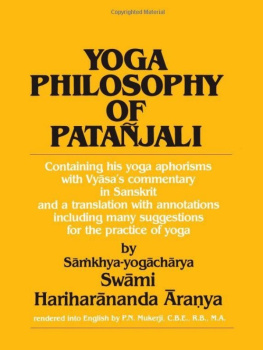
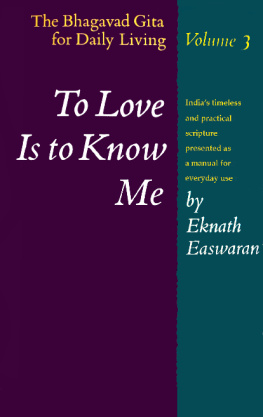
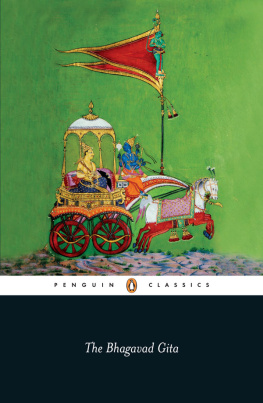
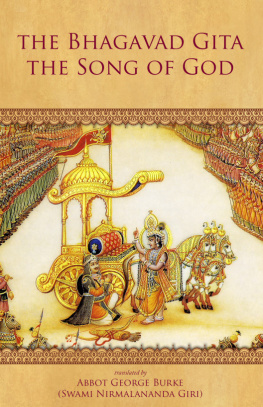
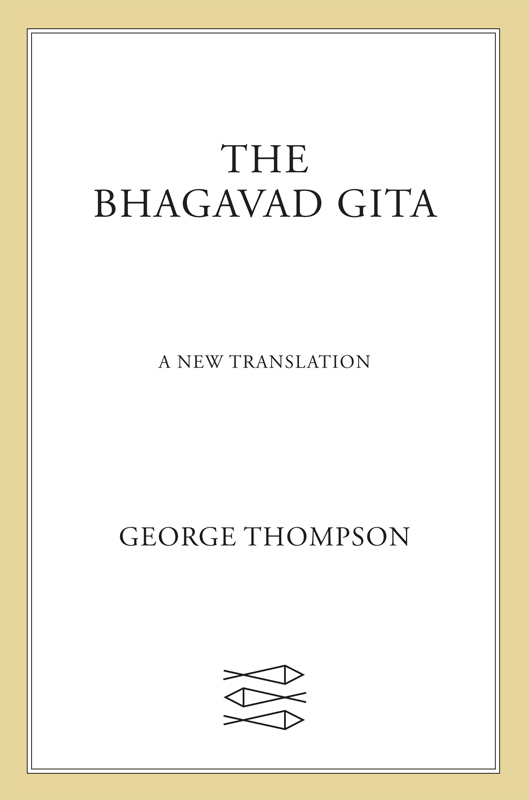

 c ak
c ak  re param vyman ysmin dev
re param vyman ysmin dev  dhi vve ni
dhi vve ni  |
|
 ubh . Occasionally the Bhagavad Gt shifts into longer quatrains of four lines of eleven syllables, in interesting ways and at interesting times. But I think it has been a mistake to try to imitate or reproduce the quatrain stanzas in English.
ubh . Occasionally the Bhagavad Gt shifts into longer quatrains of four lines of eleven syllables, in interesting ways and at interesting times. But I think it has been a mistake to try to imitate or reproduce the quatrain stanzas in English.